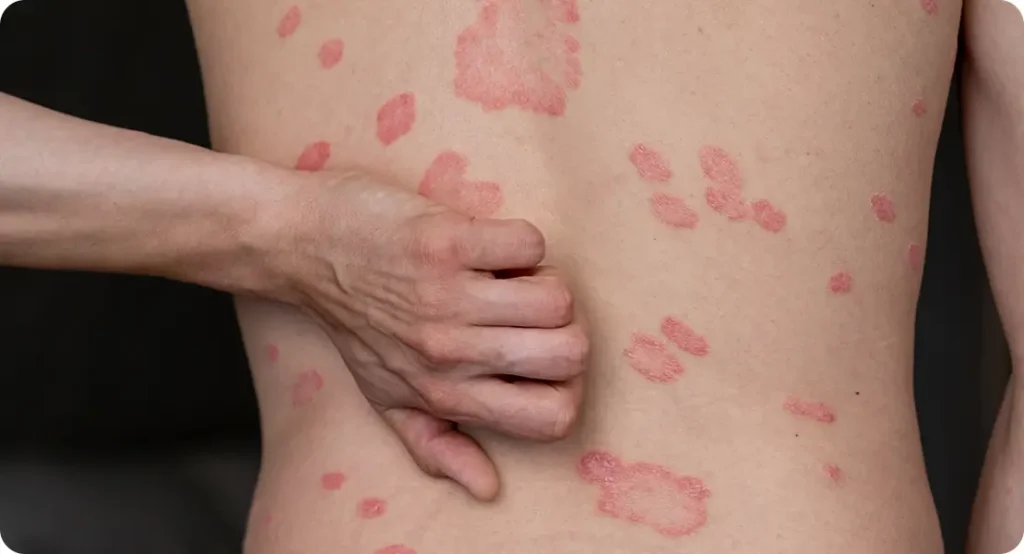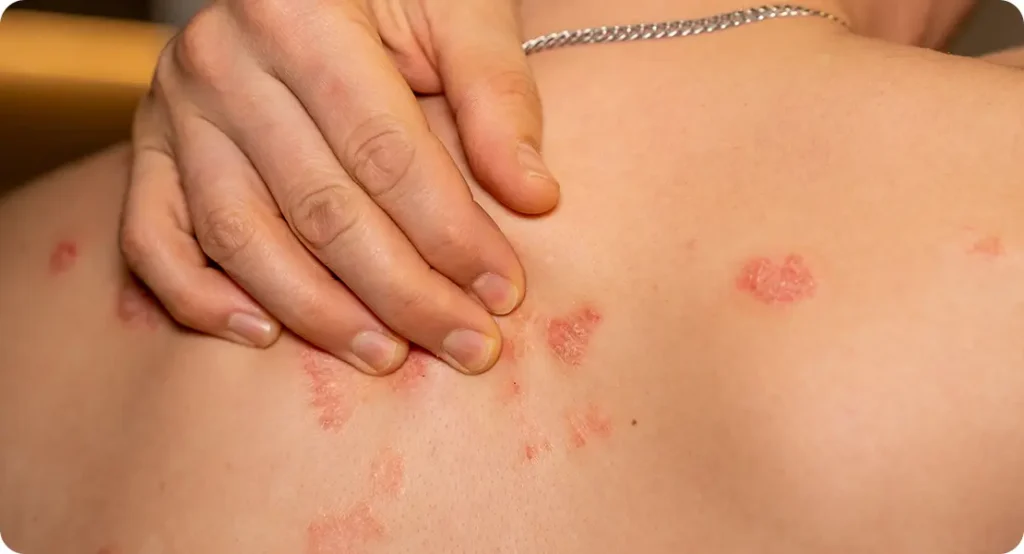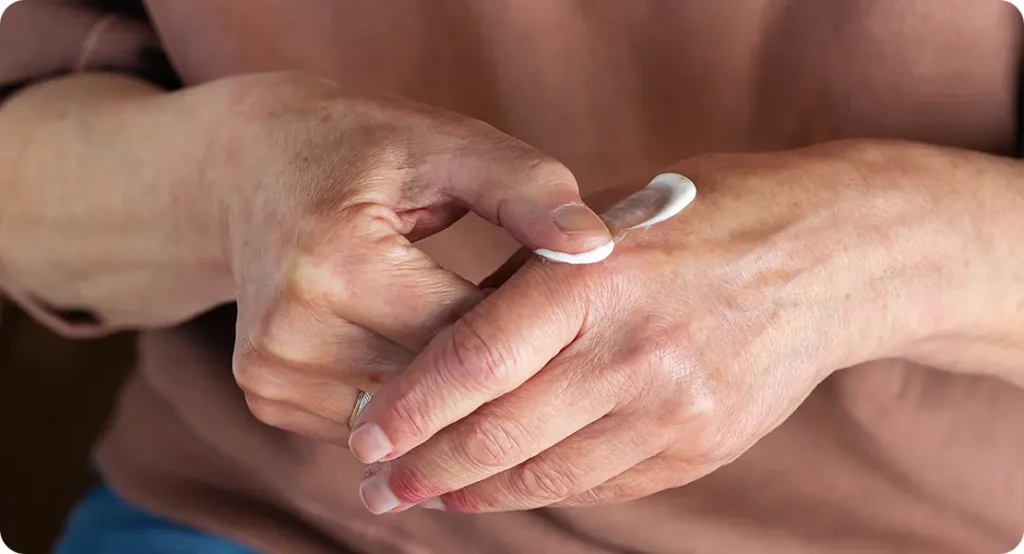Most of us have experienced hives at some point a sudden outbreak of itchy, red welts on the skin that seem to appear out of nowhere. These raised patches can be uncomfortable and unsightly, but in many cases, they fade within a few hours or days. Often, they’re caused by common triggers such as allergic reactions, infections, heat, stress, or even insect bites.
However, when hives don’t go away quickly or when they keep coming back regularly for six weeks or longer you may be dealing with a condition known as chronic urticaria. Unlike typical hives, chronic urticaria can linger for months or even years, flaring unpredictably and affecting different areas of the body at different times.
This persistent skin condition isn’t just physically uncomfortable. The constant itch, swelling, and visible skin changes can have a serious impact on your daily life. Many people find their sleep is disturbed, their confidence takes a hit, and their ability to focus or enjoy normal activities is compromised. And because the exact cause isn’t always clear, it can also feel incredibly frustrating to manage without professional help.
The good news? You don’t have to navigate this alone. With the support of a skilled dermatologist, chronic urticaria can often be brought under control. Dermatologists have the training and tools to accurately diagnose the type of hives you’re experiencing, investigate possible triggers (including autoimmune or internal causes), and design a personalised treatment plan.
In this guide, I’ll walk you through what chronic urticaria is, why it develops, and how expert dermatologists in London diagnose and treat this often misunderstood condition so you can finally get the relief you deserve.
What Is Chronic Urticaria?
Chronic urticaria is the medical term for hives that persist for six weeks or longer. Unlike short-lived hives that may be triggered by a specific allergy or irritant and disappear within a few days, chronic urticaria keeps coming back or never fully goes away.
These hives can:
- Appear daily or almost daily, often without warning
- Vary in size, shape, and location, even within the same day
- Change rapidly, with one area clearing up while new welts emerge elsewhere on the body
The welts themselves are typically red or skin-coloured, raised above the surface of the skin, and can range from a few millimetres to several centimetres across. Common symptoms include:
- Intense itching, which can interfere with concentration, sleep, or everyday activities
- A burning or stinging sensation, particularly in sensitive areas
- Swelling of deeper tissues a condition known as angioedema which may affect the lips, eyelids, hands, feet, or even the throat in more severe cases
For some people, the condition gradually fades over time, often without a clear explanation. But for many others, chronic urticaria can last for months or even years, requiring ongoing medical support and symptom management. The unpredictable nature of flare-ups can make the condition especially challenging, which is why it’s important to seek professional help if symptoms persist.
Types of Chronic Urticaria

When diagnosing chronic urticaria, dermatologists generally divide the condition into two main categories based on what triggers the hives. Understanding which type you have is key to choosing the right treatment and avoiding unnecessary flare-ups.
1. Chronic Spontaneous Urticaria (CSU)
- The most common type, accounting for the majority of chronic cases
- Hives appear and disappear without any clear external trigger
- Symptoms may occur at any time, even during rest or sleep
- In some cases, linked to autoimmune conditions, where the immune system mistakenly attacks healthy skin cells
People with CSU may also have other autoimmune-related symptoms, and their urticaria may be more persistent or resistant to standard antihistamines. However, with proper diagnosis and care, effective management is still possible.
2. Chronic Inducible Urticaria (CIndU)
Hives or swelling are triggered by specific, identifiable stimuli, such as:
- Physical pressure or friction on the skin (dermographism)
- Exposure to heat or cold
- Sunlight (solar urticaria)
- Water (aquagenic urticaria)
- Exercise or sweating
Symptoms usually develop shortly after exposure and fade once the trigger is removed
This form is less common but often easier to track and manage because the triggers are known. Avoiding or minimising exposure to those specific stimuli can significantly reduce flare-ups.
Many patients experience a mix of both types, with spontaneous hives that are also worsened by physical or environmental triggers. That’s why a thorough medical assessment is crucial. A dermatologist can help identify which type or combination you have, and tailor your treatment plan accordingly.
Why See a Dermatologist?
When hives keep returning or persist for weeks, it can be tempting to try and manage the symptoms yourself using over-the-counter antihistamines or home remedies. And while that may help in some mild, short-term cases, chronic urticaria is more than just a temporary skin irritation it’s a complex medical condition that often requires professional intervention.
You should consider seeing a dermatologist, especially if your symptoms:
- Interfere with your daily life, including sleep, work, or social activities
- Cause ongoing stress, anxiety, or embarrassment, especially when visible
- Involve swelling of the lips, tongue, or throat, which may signal a serious reaction requiring urgent care
- Don’t respond to standard over-the-counter antihistamines or keep recurring despite treatment
Here’s why specialist care matters:
- Accurate diagnosis
Chronic urticaria can sometimes resemble other skin or autoimmune conditions, such as vasculitis, urticarial dermatitis, or mastocytosis. A dermatologist can rule out these lookalike conditions through clinical examination, allergy testing, and blood work ensuring you get the right treatment from the start. - Access to advanced therapies
When regular antihistamines aren’t enough, dermatologists can prescribe stronger or non-sedating antihistamines, leukotriene receptor antagonists, immune-modulating drugs, or even biologic treatments like omalizumab. These therapies are not available over the counter and require expert supervision. - Expert monitoring and follow-up
Because chronic urticaria can be unpredictable, long-term medication needs to be carefully monitored to minimise side effects and adjust the treatment as needed. A dermatologist will guide you through the safest and most effective approach while tracking your progress over time.
In short, seeing a dermatologist gives you the best chance of understanding your condition, finding relief faster, and avoiding unnecessary frustration or risks from inappropriate self-treatment.
Diagnosing Chronic Urticaria

Proper diagnosis is a crucial first step in managing chronic urticaria effectively. While the condition often seems unpredictable, a thorough clinical assessment can help identify possible triggers, rule out lookalike conditions, and guide the most appropriate treatment plan.
During your consultation, your dermatologist will begin by:
- Taking a detailed medical history, including when the symptoms started, how often they occur, and how they affect your daily life
- Examining your skin carefully to assess the appearance, pattern, and distribution of hives or swelling
- Asking questions about lifestyle factors, including your diet, stress levels, exercise habits, recent illnesses, and any new medications or supplements
To support the diagnostic process, you may be asked to keep a symptom diary. This simple but valuable tool helps track:
- When the hives appear (time of day, activity)
- What you were doing or exposed to at the time
- Foods or drinks consumed
- Any medications, supplements, or skincare products used
- Environmental factors like temperature, pressure, or sunlight
Keeping a record over a few weeks can help identify patterns that may not be immediately obvious and assist in distinguishing between chronic spontaneous and inducible urticaria.
In some cases, further investigations may be recommended to rule out underlying causes or contributing factors:
- Blood tests to screen for signs of autoimmune activity, inflammation, or thyroid dysfunction, all of which can sometimes be associated with chronic urticaria
- Allergy testing such as skin prick or blood tests if your dermatologist suspects specific allergens are triggering your symptoms
While chronic urticaria often has no clear cause, this comprehensive approach helps ensure no important detail is overlooked, and that your treatment plan is both safe and targeted to your specific needs.
How Dermatologists Treat Chronic Urticaria
Chronic urticaria can be challenging, but with expert care, many patients achieve long-term relief. Dermatologists follow a stepwise treatment approach, beginning with the least intensive option and escalating only if necessary. This ensures effective symptom control while minimising the risk of side effects.
1. Standard-Dose Antihistamines
This is the first-line treatment for most patients.
- Non-sedating antihistamines such as cetirizine, loratadine, or fexofenadine are taken once daily
- These medications help block histamine a chemical involved in allergic reactions thereby reducing itching, swelling, and redness
- Many patients with mild to moderate symptoms find this level of treatment sufficient
2. High-Dose Antihistamines
If standard doses don’t offer enough relief, your dermatologist may increase the dosage up to four times the usual amount.
- This is a safe and well-studied approach, but it should only be done under medical supervision
- Increasing the dose gradually allows your dermatologist to monitor effectiveness and ensure you’re not experiencing unwanted side effects
3. Leukotriene Receptor Antagonists
If hives persist despite high-dose antihistamines, another medication may be added.
- Montelukast is commonly used to block leukotrienes, another chemical involved in allergic and inflammatory responses
- This is especially useful if the urticaria is partially responsive to antihistamines or worsens with exercise, cold air, or allergens
4. Short Courses of Corticosteroids
For sudden, severe flare-ups, a short course of oral corticosteroids may be prescribed.
- These medications quickly suppress inflammation, bringing rapid relief from intense symptoms
- However, long-term steroid use is avoided due to the risk of serious side effects, including weight gain, high blood pressure, and bone thinning
5. Biologic Treatments: Omalizumab (Xolair)
For patients who continue to experience symptoms despite the above steps, omalizumab has been a game-changer.
- It’s a monthly injectable treatment that targets IgE antibodies, which play a key role in the allergic response
- Omalizumab is clinically proven to reduce symptoms in many people with chronic urticaria that doesn’t respond to antihistamines
- Its safety and effectiveness make it a preferred option for many with moderate to severe disease
6. Immunosuppressive Therapies
In very rare, treatment-resistant cases, a dermatologist may consider immunosuppressive medications such as ciclosporin.
- These drugs work by suppressing the immune system’s activity, reducing inflammation and allergic responses
- Because they carry a higher risk of side effects, close monitoring is essential, and they’re typically reserved for patients who haven’t responded to any other treatments
Lifestyle and Self-Care Strategies

While medication is the foundation of chronic urticaria treatment, daily habits and lifestyle choices also play a big role in preventing flare-ups and improving quality of life. Dermatologists often recommend a combination of self-care strategies alongside medical treatment to help reduce the frequency and severity of symptoms.
Here are some simple yet effective adjustments that can make a real difference:
- Avoid known triggers
If you’ve identified specific triggers such as heat, pressure, stress, certain foods, or alcohol try to minimise your exposure as much as possible. For some people, even a hot shower or tight waistband can cause a reaction. Being aware of these factors and planning ahead can help you stay in control. - Use gentle skincare products
Harsh soaps, fragrances, and alcohol-based skincare products can irritate already sensitive skin. Opt for fragrance-free, hypoallergenic cleansers and moisturisers, and apply emollients regularly to strengthen the skin’s barrier and reduce dryness and irritation. - Wear loose, breathable clothing
Tight-fitting clothes or rough fabrics can put pressure on the skin and trigger hives especially in people with pressure-induced urticaria. Choose lightweight, breathable fabrics like cotton and avoid anything that causes friction. - Manage stress effectively
Emotional stress is a well-known trigger for chronic urticaria. While you can’t avoid stress entirely, you can learn to manage it. Relaxation techniques such as mindfulness meditation, deep breathing exercises, regular physical activity, and getting enough sleep can all help reduce flare frequency and improve overall well-being. - Keep cool
Overheating can worsen itching and cause hives to appear. Try to stay in cool environments, wear appropriate clothing, and use cool compresses or a fan during flare-ups to soothe the skin and reduce discomfort.
Incorporating these daily habits into your routine not only supports medical treatment but can also give you a greater sense of control over your symptoms. Your dermatologist can offer personalised guidance on which lifestyle changes are most relevant to your specific type of chronic urticaria.
How Chronic Urticaria Can Impact Your Life
For many people living with chronic urticaria, the condition goes far beyond physical discomfort. While the visible signs red, itchy welts or swelling are often the most noticeable, the emotional and psychological toll can be just as significant. When symptoms persist day after day, it can start to affect nearly every aspect of daily life.
Here’s how chronic urticaria may impact your overall well-being:
- Emotional health
Dealing with constant itching, unpredictable flare-ups, and visible skin changes can take a serious emotional toll. Many people report feelings of frustration, irritability, anxiety, or even depression, especially if the condition is long-standing or difficult to control. The stress of not knowing when symptoms will strike can also lead to social withdrawal or low self-esteem. - Sleep quality
Itchiness often worsens at night, making it difficult to fall asleep or stay asleep. Over time, this sleep disruption can lead to fatigue, difficulty concentrating, and a reduced ability to cope with stress all of which can worsen both your physical and mental health. - Work, relationships, and social life
Flare-ups can appear suddenly and in highly visible areas like the face, arms, or neck. This can cause embarrassment or self-consciousness, discouraging people from going to work, exercising, or participating in social events. In more severe cases, swelling (angioedema) can interfere with speaking, eating, or even breathing, making normal activities feel overwhelming.
This is why it’s so important to seek specialist support. Chronic urticaria is a genuine medical condition not something you should have to “just live with.” With the help of a dermatologist, you can take back control, reduce your symptoms, and regain the confidence and comfort you deserve.
When to See a Dermatologist Urgently
While most cases of chronic urticaria are uncomfortable rather than dangerous, certain symptoms can signal a more serious problem and require immediate medical attention. It’s important to know when your condition may be crossing the line from manageable to medically urgent.
You should seek emergency care straight away if you experience any of the following:
- Swelling that affects your throat, tongue, or lips, especially if it makes it difficult to breathe or speak
- Shortness of breath, wheezing, or a feeling of tightness in the chest
- Hives accompanied by dizziness, lightheadedness, or a rapid heartbeat
- A sudden and severe flare-up of symptoms, especially if they come on quickly and feel different from your usual pattern
These signs could indicate a serious allergic reaction known as anaphylaxis, which can be life-threatening and requires urgent medical treatment.
Even if you’re unsure whether your symptoms are severe enough to warrant emergency care, it’s better to err on the side of caution. If in doubt, contact your GP, call emergency services, or go to the nearest A&E department.
Once the immediate symptoms are managed, follow up with a dermatologist as soon as possible to investigate the cause and prevent future episodes.
Final Thought: You’re Not Alone in Managing Chronic Urticaria
Chronic urticaria can be unpredictable and frustrating but you don’t have to face it alone. Dermatologists have the expertise and tools to help you find relief and regain control over your symptoms. If you’d like personalised advice and a treatment plan tailored to you, you can get in touch with us to book a consultation with one of our expert dermatologists in London.
References:
- Zuberbier, T., Aberer, W., Asero, R., Bindslev‑Jensen, C., Brzoza, Z., Canonica, W., … & Wahn, U. (2018) ‘The EAACI/GA²LEN/EDF/WAO guideline: define urticaria – Beyond patient management’, Allergy, 73(7), pp. 1357–1367.
Available at: https://www.ncbi.nlm.nih.gov/pmc/articles/PMC4921693/ - Saini, S.S., Bindslev‑Jensen, C., Maurer, M., Grob, J.J., Bülbül Baskan, E., Bradley, M.S., … & Rosen, K. (2015) ‘Efficacy and Safety of Omalizumab in Patients with Chronic Idiopathic/Spontaneous Urticaria Who Remain Symptomatic on H₁‑Antihistamines: A Randomized, Placebo‑Controlled Study (ASTERIA I)’, Journal of Investigative Dermatology, 135(3), pp. 925–932. https://www.jidonline.org/article/S0022-202X(15)37120-7/fulltext
- Kaplan, A.P., Joseph, K. and Saini, S.S. (2014) ‘How Omalizumab came to be studied as a therapy for chronic spontaneous/idiopathic urticaria’, The New England Journal of Medicine.
Available at: https://www.nejm.org/doi/full/10.1056/NEJMoa1215372 - Maurer, M., Rosén, K., Hsieh, H.J., Saini, S., Grattan, C., Gopalan, G., … & Baker, M. (2016) ‘Omalizumab for the treatment of chronic spontaneous urticaria: pooled analysis of three phase III studies’, Journal of Allergy and Clinical Immunology, 137(2), pp. 474–481. https://www.jacionline.org/article/S0091-6749(16)00194-9/fulltext
Salman, A. and Giménez‑Arnau, A.M. (2023) ‘Acute and Chronic Urticaria: Diagnosis and Management Taking into Account Their Differences’, Current Treatment Options in Allergy, 10, pp. 130–147. https://link.springer.com/article/10.1007/s40521-023-00333-w
